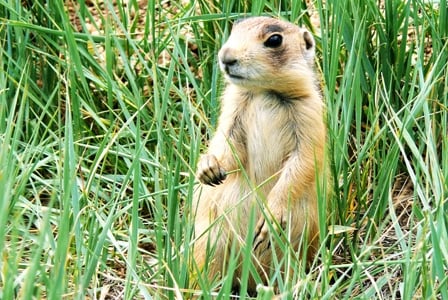
Trouble began for these little prairie dogs way back in the 1920s. Find out why theyre still trying to dig their way out almost 100 years later.
What’s behind a name? In this case, the first pioneers to settle the western Great Plains decided on the name “prairie dog” when they saw sprawling towns of the observant little rodents peeking their heads above the long grasses.
On this Wildlife Wednesday, we head to Utah to dig up some details about the locals (local prairie dogs, that is).
Habitat
The home range of these furry little den dwellers is in … Utah. More specifically, they’re found in areas with low-growing vegetation in the southwestern area of the state. This way, when they stand on their back feet in the typical prairie dog pose, they can see what’s around them.
Trivia
- Utah prairie dogs are the smallest prairie dog species out there. They measure only 12 to 14 in (30 to 35 cm) from head to tail and weigh only about 1 to 3 lb (0.5 to 1.4 kg).
- They’re also extremely social, living underground in expansive burrows that have a number of entrances and exits to allow for easy refuge from large or airborne predators and easy escape from anyone who might invade.
- What do you call a group of prairie dogs? Even though they have “dog” in their names, they don’t make packs—they form colonies or towns. If the colony is big enough, they’ll also split into subgroups called “coteries.”
- Like Hogwarts houses and other exclusive cliques, rivalries crop up between coteries. Stronger coteries may invade the territory of weaker ones, and males may invade the burrows of their rivals.
- What’s the deal with prairie dogs pretending they’re people? The prairie dogs that are so often seen standing on their hind legs are the lookouts for their respective colonies. They watch out for coyotes, golden eagles, and other predators, barking a warning when a danger is seen.
- Lookouts also work together to distract hungry predators, drawing attention from one prairie dog to the next so that any one animal won’t be turned into lunch.
Why are they threatened?
Problems began for these little prairie dogs in the 1920s, when control methods first began. By the 1960s, these methods, combined with drought, habitat destruction, and disease, left their formerly robust population size in shambles.
Current threats include urbanization, poaching by hunters and farmers who fear that the animals will affect their crops, outbreaks of disease, and drought. Their current habitat is also undergoing change; because of grazing livestock, shrubbery has started to overtake parts of their grassland range, resulting in conditions that aren’t very conducive to lookout duty.
However, things might just be looking up for these observant little dirt-dwellers. Since their inclusion on the US Fish and Wildlife List of Threatened and Endangered Species in 1973, their numbers have started to stabilize, allowing them to be downlisted from endangered to threatened.



